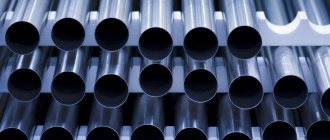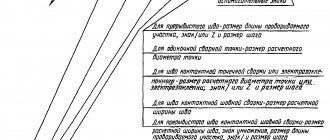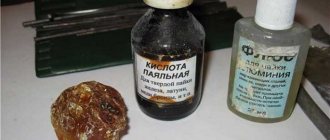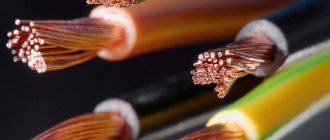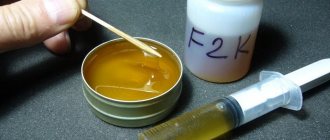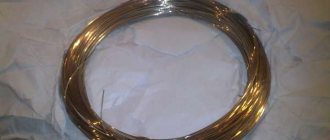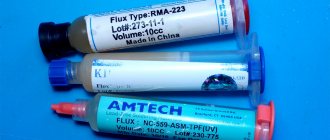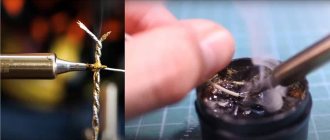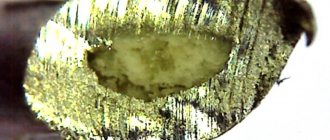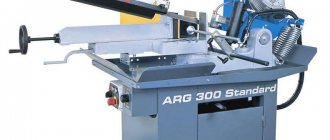When working with various electronic or radio components, both specialists and amateurs use a special mixture - soldering flux. Its composition can be very different. Soldering flux today as a product is presented in a wide range: in the form of powder, paste or liquid. The composition of the substance can be organic and inorganic. Flux LTI-120 is very popular among consumers.
Main technical characteristics
Flux labeled in this way can be produced by different manufacturers. But its composition, of course, is always the same. This substance was developed by the Leningrad Technological Institute. Hence its labeling - LTI.
LTI-120 is a dark liquid supplied to the market in bottles, canisters or vials. It belongs to the group of corrosive, low-temperature, activated fluxes. In some cases, the presence of a small amount of colloidal formations in the liquid is allowed.
This substance is not washed off from the surface of parts with water during operation. The temperature range of the LTI-120 flux is 160-350 degrees. When using this substance, solders can be either soft tin-lead or silver (provided that the flux is completely removed at the end of the work). The temperature of maximum activity of this product is 250...300 °C.
Soldering flux LTI-120, therefore, does not dissolve in water. At the same time, it belongs to the class of neutrals. That is, after soldering, it is usually not necessary to remove its remains. But if necessary, you can, of course, wash it off from surfaces. For this you need to use acetone or alcohol. Some craftsmen wash off this flux simply with cheap vodka.
What is the substance?
During soldering work, when heated, parts can oxidize. As a result of the formation of an oxide film on their surfaces, such parts are poorly wetted by solder. In order to dissolve this film and facilitate soldering, special substances are used, which are called soldering fluxes.
Flux LTI-120 is a dark-colored liquid. For transportation and storage of this substance, special bottles, canisters or vials are provided. LTI-120 belongs to the corrosive, low-temperature, activated groups of fluxes. Sometimes colloidal formations may be present in small quantities.
What materials can you work with?
For what parts is soldering allowed using this flux? LTI-120 can be used when working with elements made from:
- of stainless steel;
- zinc;
- nichrome;
- lead;
- cadmium;
- palladium;
- copper and its alloys.
Very often this substance is also used for soldering silver.
TYPES OF FLUXES
TYPES OF FLUXES
Fluxes. Complete collection: corrosive and non-corrosive, active and passive. The table below shows fluxes produced specifically for soldering.
| Photo of flux | Title and description | Compound |
| Pine rosin This simplest and cheapest neutral flux has already become a true “classic of the genre”! Cheap, has low leakage current and low corrosiveness. | ||
| Orthophosphoric acid is used in soldering as a flux (on oxidized copper, on ferrous metal, on stainless steel), for research in the field of molecular biology. It is also used to clean rust from metal surfaces. Forms a protective film on the treated surface, preventing further corrosion. | ||
| Soldering acid For soldering carbon and low-alloy steels, copper, nickel and their alloys. Active in the temperature range 290-350 °C. Washing with a 5% soda ash solution is recommended. | ||
| Soldering acid PET Application: soldering of carbon steels, copper, nickel and their alloys with low-melting solders at a temperature of 150 – 320°C. | ||
| Active soldering fat Used for soldering highly oxidized parts made of ferrous and non-ferrous metals Vaseline base | Ingredients: zinc chloride, ammonium chloride, hydrochloric acid, wetting additive “SOLINS”, deionized water. | |
| Neutral soldering fat Recommended for high-quality soldering of radio engineering devices. | ||
| Alcohol “Isopropanol” Absolute isopropyl alcohol (isopropanol) is used in: printing, chemical, oil, furniture, wood chemical, and perfume industries. Isopropyl alcohol (isopropanol) absolute is a good solvent for various essential oils, when washing high-tech components and assemblies, as a dehydrating and degreasing agent. | ||
| BORAHOUS Used for high-temperature soldering of carbon steels, cast iron, copper, hard alloys with copper and silver soldering alloys. | ||
| Glycerin flux TAGS This glycerin flux is used for soldering radio installation elements. When soldering printed circuit boards, it has residual resistance and requires mandatory cleaning with water or alcohol. | ||
| ZIL-2 Designed for soldering steel, cast iron, copper with low-tin solders or bismuth-based solders. | ||
| ZIL-2 PET Used for soldering brass, copper and its alloys | ||
| LTI-120 Flux LTI-120 – for soldering stainless steel, zinc, silver, copper and its alloys. Neutral, no cleaning required after soldering. Dissolves in alcohol and acetone. | Rosin – 25 Diethylamine hydrochloride – 5 Triethanolamine – 1 Ethyl alcohol – 69 | |
| LTI-120 PET Application: soldering of radio installation elements, printed circuit boards, carbon steels, zinc with fusible solders at temperatures of 200 – 300°C. Ingredients: pine rosin, alcohol, activators. | ||
| Soldering acid For soldering carbon and low-alloy steels, copper, nickel and their alloys. Active in the temperature range 290-350 °C. Washing with a 5% soda ash solution is recommended. | ||
| SKF (FKSp) Alcohol rosin flux SKF with a brush (aka CE, FKEt, FKSp). Application: soldering of radio installation elements and printed circuit boards with low-melting solders at temperatures of 250-280°C. Ingredients: pine rosin - 20-30%, monohydric alcohol (ethyl or isopropyl, or a mixture) - 80-70%. | ||
| SKF (FKET) For soldering copper and its alloys. The temperature range of activity is 250-280 °C. Cleaning: alcohol, gasoline, acetone. | ||
| TAGS PET Application: soldering of carbon steels, copper, nickel and their alloys with low-melting solders at a temperature of 150 – 320°C. | ||
| F-38N PET The most active soldering flux on the market. If the flux activity is too high, dilute it with an equal amount of ethyl or isopropyl alcohol. Application: soldering of nichrome, constantan, manganin, beryllium and aluminum bronze, corrosion-resistant steels with fusible solders at a temperature of 300°C. contains phosphoric acid, glycols and organic hydrochlorides. | ||
| FIM For soldering copper, constantan, silver, platinum, stainless steel and ferrous metals. Requires washing with water. Chemically active in the temperature range 290-350 °C. | ||
| FIM PET Highly active soldering flux. Application: soldering of stainless steels and bronzes (especially aluminum and beryllium) with fusible solders at temperatures of 150 – 300°C. The flux contains phosphoric acid. | ||
| FIM (active) For soldering copper, constantan, silver, platinum, stainless steel and ferrous metals. Requires washing with water. Chemically active in the temperature range 290-350 °C. | ||
| FCDT. Designed for manual and mechanized soldering and tinning of electrical installation elements and other metal surfaces of printed circuit boards and electrical electronics terminals in electronic equipment products. Neutral, flux residues after soldering do not affect the insulation resistance of dielectrics. | ||
| FCT PET. Designed for manual and mechanized soldering and tinning of electrical installation elements and other metal surfaces of printed circuit boards and terminals of radio electronics elements in radio electronic equipment products. Neutral, flux residues after soldering do not affect the insulation resistance of dielectrics. Flux residues after soldering are not corrosive. | Made on the basis of extraction rosin “A” or “B” (GOST 19113-84), alcohol and a neutral wetting additive - dipentene tetrabromide (according to TU 13-0281078-140-93). | |
| FTS For soldering parts of radio-electronic equipment. Neutral, does not contain rosin, washes off easily with water. It has low corrosive activity, is heat-resistant, and does not smoke. | ||
| FTS PET. Manual and mechanized soldering of printed circuit boards. Tinning of electrical installation elements and other metal surfaces of printed circuit boards and electrical electronics terminals in electronic devices and electronic devices with low-melting solders at a temperature of 150 – 300°C. Removal of flux residues is required. | ||
| Orthophosphoric acid It is used as a flux or as a 5% aqueous solution as a rust converter. | ||
| Soldering paste “Tinol” is used for hot air soldering of SMD components. Provides high-quality soldering. Flux residues after soldering are non-hygroscopic, non-conductive and non-corrosive. The temperature of complete melting of solder is 200 °C. | ||
| For aluminum. No laundering. If necessary, excess flux can be wiped off with a rag. In addition to soldering aluminum, it can be used for soldering stainless steels, nickel, copper and other metals. | ||
| Neutral radio mounting flux-gel is used for soldering electronic components. Corrosively passive. Non-drying. Washable with alcohol and acetone. Bottle with dispenser cap. 10 ml. | ||
| Flux-gel TT. Used for high-quality soldering of electronic components. The flux contains an activity indicator. After installation, the red flux becomes discolored, which indicates the absence of an active component at the soldering site, and therefore there is no need for cleaning. | ||
| FTS (water-washable) Used for soldering parts of electronic equipment. Neutral, does not contain rosin, washes off easily with water. It has low corrosive activity, is heat-resistant, and does not smoke. | ||
| CT-61A acid-free solder paste Provides high-quality soldering. Flux residues after soldering are non-hygroscopic, non-conductive and non-corrosive. The temperature of complete melting of solder is 200 °C. CT-61B solder paste Solder paste for soldering electronic elements, circuits in computer and mobile equipment. CT-61C solder paste (rosin) Provides high-quality soldering. Flux residues after soldering are non-hygroscopic, non-conductive and non-corrosive. The temperature of complete melting of solder is 200 °C. Jar 10 g. | ||
| IF 9007 Interflux BGA soldering paste. Solder IF 9007´ is recommended for use in lead soldering. Its formula allows the third type of paste grit (25-45µ) to be applied using a syringe. It has No-clean properties with minimal halogen content. Leaves a thin, invisible layer of flux. | ||
| FMKANC32-005. Flux cream is high-quality, rosin-based, no-clean, slightly activated FSW32, DIN8511, 5 ml syringe cartridge with piston and needle. Best results when soldering BGAs as well as QFPs using microwaves. | ||
| Soldering paste BS-10 (active). High activity allows you to solder even oxidized surfaces of ferrous and non-ferrous metals. Not suitable for soldering printed circuit boards! Residues are easily washed off with Galosh gasoline or isopropanol. | Composition: – Vaseline (base) 80-90% – Paraffin 6-9% – Zinc chloride 4-6% – Ammonium chloride 1-3% – Water 2-4% | |
| IF 8001 Interflux Liquid soldering flux for lead-free SMD soldering. IF 8001 is a no-clean, high-quality alcohol-based synthetic flux. Does not contain halogens. Apply using a flux pen or brush. Does not require washing. If necessary, it can be easily removed using solvent-based removers. Guaranteed shelf life in a tightly closed container at a temperature of 5-35°C is 1 year. Yellow color | ||
| Pacific 2008 Interflux Soldering flux liquid Pacific 2008 is a harmless flux, specially designed for manual and selective soldering of poorly wetted, non-wettable and heat-intensive SMD components, because remains active for the additional time required when soldering such components. Does not contain halogens. Water washable. Does not require washing. Density at 20°C: 1.006 g/ml Colour: colorless Odour: sweet | ||
| Flux gel IF 8300 BGA Interflux (30cc) Flux gel BGA IF 8300-4 is used in lead-free soldering for mounting elements in BGA packages. The flux has rosin rheological properties. Halogen-free, which ensures reliable retention of elements on the printed circuit board. |
The fluxes presented above are presented as those specifically designed for soldering, as well as alternative ones that are not fluxes, but which can act as a flux.
We have described a list of fluxes and recipes that are used for soldering. This reference material will undoubtedly be useful to both beginners and experienced radio amateurs. We are waiting for your comments, wishes, opinions. Material provided by A. Kulibin
FORUM on amateur radio chemistry.
- AMATEUR RADIO WORKPLACE
LTI-120: flux composition
This substance intended for soldering is manufactured using the following materials:
- pine rosin grade “A” (20-25%);
- triethanolamine (1-2%);
- diethylamine hydrochloride (3-5%);
- ethyl alcohol (90-95%).
Flux LTI-120, therefore, does not have a particularly complex composition. Cooking it at home, of course, is not very easy. But many craftsmen, if it is not available in specialized stores, select the appropriate components and mix such a flux, including on their own. This is explained primarily by the fact that the actual technology for preparing this substance is not particularly complicated.
Price
Among the advantages of LTI flux, consumers, among other things, include its low cost. Most often, this soldering liquid is supplied to stores in 30 ml bottles. There are also 20 ml bottles of this product on sale. They usually come with a brush. Soldering flux LTI-120 in such a container costs only about 30-50 rubles.
Industrial enterprises can purchase this substance in 500 ml bottles. One such container costs approximately 300-550 rubles. depending on the manufacturer. Sometimes this flux is sold in large canisters up to 5 liters. In such a container, the substance costs about 2000-2500 rubles.
Consumer Reviews
In addition to its low cost, consumers attribute the advantages of the LTI-120 flux, first of all, to the fact that in most cases it comes with an easy-to-use brush. Thus, the master does not have to look for such a tool separately. Working with the LTI flux brush is actually very comfortable. Also, many craftsmen praise this substance for the fact that it does not conduct electric current. It is believed that they are very convenient for soldering not only printed circuit boards, but also just wires. Tinning using this substance, according to many craftsmen, is much more convenient than using the same alcohol rosin.
Flux LTI-120 also earned good reviews from consumers because it does not have to be washed off after work. If necessary, it is very easy to remove from the material with alcohol.
Another undoubted advantage of this flux is that it is usually supplied in non-spillable bottles. That is, during operation there is no particular need to monitor the stability of the container with it.
According to most consumers, this flux has virtually no disadvantages. Even a volume of 20 ml is considered by most masters to be very convenient. This bottle doesn't take up much space in your toolbox. At the same time, LTI-120 flux lasts for a long time. Some of the disadvantages of this substance, experts attribute only to the fact that it dries too quickly.
Flux LTI-120: use at home
When using this substance, it should be borne in mind that its residues may have a corrosive effect on copper elements after soldering. They do not affect tin, nickel and silver coatings in this way. Residues of LTI-120 flux, although slightly, reduce the resistance of products.
When working with this substance, as with any other chemical, of course, safety precautions should be observed. Under no circumstances should flux get into the stomach, mucous membranes or eyes. When soldering using this substance, be sure to use a brush. If flux gets on the skin, the affected area should be thoroughly washed under running cold water and soap.
Purpose
Flux is used during soldering of radio components and electronics, hot tinning. It is required for:
- reducing the surface tension of the solder in the molten state;
- eliminating oxidation of surfaces and working materials during soldering or tinning;
- cleaning the surface from oxidative film.
Return to content
How is flux made?
In the production of this substance, enterprises use the following materials:
- Triethanolamine TU 6-02-916-79 (2 g).
- Pine rosin GOST 19113-84 (25 g).
- Ethyl alcohol GOST 18300-87 (68 g).
- Diethylamine hydrochloride TU 6-09-5395-88 (5 g).
Cotton wool GOST 5556-81 and canvas stitching fabric TU 8399-001-48212332-03 are also used.
The tools and equipment used are:
- fume hood;
- scales and spatula;
- mortar and pestle;
- household clock.
The flux itself is prepared using the following technology:
- rosin is weighed on scales and ground into powder;
- ethyl alcohol is weighed and added to the rosin;
- everything is thoroughly mixed;
- triethanolamine and diethylamine hydrochloride are added to the resulting solution;
- everything is mixed well again.
The solution obtained in this way is kept for 20-30 minutes, and then bottled with airtight lids.
How is flux made?
Factory production fully complies with OST 4GO.033.200. the following components are used:
- ethanol – 68 g;
- diethylamine hydrochloride – 5 g;
- triethanolamine – 2 g;
- pine rosin “A” – 25 g.
All materials must comply with regulatory documents. The same applies to cotton wool and canvas stitching.
It is possible to make LTI-120 flux with your own hands if you completely follow the factory instructions:
- grind the rosin to a powder state;
- add it to ethanol;
- mix;
- add the remaining components;
- mix.
The resulting liquid is left for half an hour, after which it is poured into clean flasks with a hermetically sealed seal.
Return to content
How flux is checked at enterprises
Of course, before hitting store shelves, this substance undergoes the most thorough quality control at the factory. To do this, first take a small sample of the solution. Next, the flux is applied in a thin layer to the glass plate. Then the drying time at 30 °C is determined. If after 60 minutes the surface is still wet, the solution is rejected.
To determine the amount of non-volatile substances, the sample is placed on a scale with an accuracy of 0.1 g. 9-10 grams of the substance are poured into a porcelain cup. Dry the flux in it for 3 hours at a temperature of 100 °C. Next, weigh the container and compare the result with that obtained previously. The calculation is performed using the formula: % non-volatile = (b – a) × 100/s, where a is the weight of the cup, b is the weight of the container with the dry residue, c is the initial weight of the flux being tested.
Also, using special technologies, before delivery to stores, the color of the substance and its reaction to phenolphthalein and methyl orange are checked. When the latter is added, the flux should turn yellow. When tested with phenolphthalein, on the contrary, the substance should not change its color in any way. If the color is pink, the flux is rejected.
Flux LTI Lux
This modification has also earned good reviews from many craftsmen. The performance characteristics of the LTI-120 Lux are simply excellent. Consumers praise it primarily because it is devoid of the main drawback of the base substance. This variety dries much more slowly. This property of LTI-120 Lux is primarily due to the fact that it is made on the basis of water. This modification does not contain any volatile solvents.
Thus, there is no ethyl alcohol in LTI-120 Lux. But all the other components in it are exactly the same as in the base solution. In addition to soldering itself, this new flux can also be used for cleaning parts. With its help, you can easily and quickly remove any dirt from the boards. This substance is less dangerous in work than flux 120. Some craftsmen even wash their hands with it.
In order to save on material, LTI-120 Lux can be spread in a very thin layer. The difference in its operation compared to the 120 modification lies primarily in the fact that it hisses quite loudly and also steams a little. But after using it, it is impossible to see any rosin residues on the boards.
How does the product work?
Using this substance you can both solder wires and work with boards. Due to its liquid consistency, flux is not very convenient to use at the beginning of soldering, since it is spread in a thin layer and dries very quickly. To fix this, before soldering wires or boards, you need to let the flux sit for a while. To do this, pour a small dose of the substance into a separate container for a while (this could be a bottle cap). It is recommended to perform this procedure several days before soldering work. During this time, the flux should dry out a little and thicken. Before soldering boards or other electrical and radio components, you should check the condition of the substance. It should resemble liquid honey. In this consistency, LTI-120 is convenient to apply with a sharp toothpick to the desired surfaces. If the soldering flux turns out to be very thick, it can be diluted a little with a small amount of alcohol or a new portion of the same LTI-120. When working with printed circuit boards, it is important to ensure that there is no overheating when tinning their tracks. Otherwise, these tracks may disappear. It is quite easy to coat them with LTI-120, and then run the end of a soldering iron with a small amount of solder over each of them. This will ensure high-quality tinning of the tracks and give them an almost mirror-like surface.
When soldering wires, tinning, according to experts, is best done for each wire separately. If the wire is soldered to a printed circuit board, it is recommended to make a small hole in it. Only after this can a tinned wire be inserted into it from the back of the printed circuit board and soldering begin. This method will ensure reliable fastening: with a strong jerk, the track will not come off.
As many manufacturers claim, these soldering fluxes are inactive and do not need to be washed off. But judging by numerous reviews, some craftsmen and radio amateurs are still confused by the presence of additives, and after finishing work they prefer to wash off the remaining fluxes. This is done using wide brushes, which are pre-moistened with alcohol. Some people use regular brushes and plenty of tap water. According to the assurances of such craftsmen, there is nothing wrong with the fact that the finished board is wetted with water. The main thing is to dry it thoroughly afterwards.
When using this soldering flux, you should not forget that it is a chemical and working with it requires compliance with safety rules. During tinning, you should protect the mucous membranes of the stomach and eyes. The work is carried out using a brush, which is attached to the LTI-120 kit. If soldering flux gets on your skin, the affected areas should be washed with plenty of water and soap.
Fakes
The reviews from the masters of flux LTI-120 and its new modification are simply excellent. But such substances are produced today by no less than five different manufacturers. Therefore, when purchasing, it is quite difficult to distinguish an original solution from a fake. Unfortunately, there are many products on the market today that are labeled in this way and have nothing to do with real flux.
It’s very easy to run into a fake LTI-120 these days. But it is still possible to distinguish such a remedy from the real one. To do this, you just need to carefully smell the flux. Counterfeits usually have a very strong and pungent smell of ammonia. The original flux 120 smells, according to many consumers, quite pleasant.
